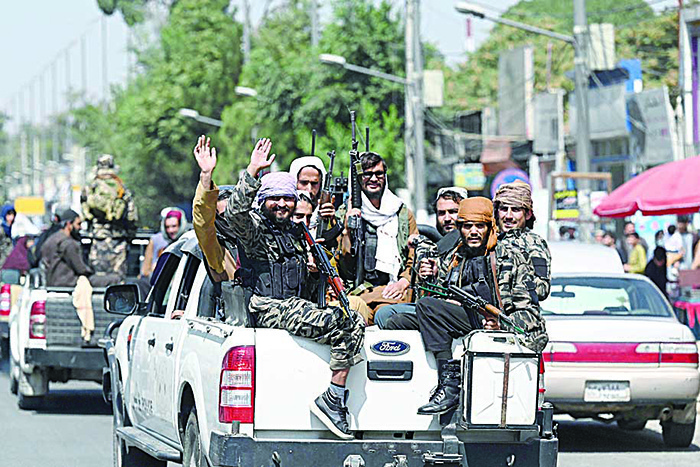 KABUL: Taleban fighters wave as they patrol in a convoy along a street in Kabul yesterday. —AFP
KABUL: Taleban fighters wave as they patrol in a convoy along a street in Kabul yesterday. —AFP
WASHINGTON: Most Afghan allies seeking to flee with the US withdrawal were unable to do so, an official acknowledged Wednesday, as the United States began to wrestle with painful choices in the chaotic final days of the war. President Joe Biden’s administration says the victorious Taleban have promised to keep letting Afghans leave-but many who worked for the United States over its 20-year mission fear retribution.
“These have been incredibly emotional and trying days, and indeed years,” said General Mark Milley, the top US military officer. “We are all conflicted with feelings of pain and anger, sorrow and sadness, combined with pride and resilience,” he said. A senior State Department official vowed to keep working to help everyone leave. “Everybody who lived it is haunted by the choices we had to make and by the people we were not able to help depart,” he said on customary condition of anonymity.
The last American soldier left Afghanistan just before a deadline set by President Joe Biden of August 31, closing more than two decades of war that began with the US-led invasion in the wake of the September 11, 2001 attacks and ended with the Taleban back in power. The United States in the final days of the war airlifted more than 123,000 people out of Kabul’s airport, including US citizens and interpreters and others who supported the US mission and are eligible for a special visa to immigrate.
Biden has hailed the airlift as unprecedented, but the State Department official acknowledged that most Afghan visa applicants and their families did not make it. “I would say it’s the majority of them,” the official said. He declined to give exact numbers. The White House said in early August that some 20,000 Afghans were seeking to emigrate through the visa program, meaning more than 100,000 people including families.
Children separated
Despite multiple reports of the Taleban beating and harassing Afghans trying to reach Hamid Karzai International Airport, which was seized by US forces, the official said that they cooperated, generally letting people through. But he said the crowd at the gates became unruly, with the credentials issued by US forces quickly proliferating.
“It’s not a criticism of the people who were desperate to leave,” the official said, adding that the crowds were “on the verge of slipping to a mob at any given moment.” Security fears gave edge to the chaotic effort. On August 26, a suicide bombing claimed by the Islamic State extremist group killed more than 100 Afghans and 13 US soldiers. One veteran State Department official who was sent to the airport said, more than 30 children, including babies, were separated from their parents each day in the “horrendous” effort to reach the facility.
She recalled a boy of 13 or 14 years old who came with blood on his clothes. “I asked him what happened, how he got separated from his family, and he said that somebody was killed right in front of him and his whole family dispersed,” she said. Norway initially set up a center to reunite children with their parents and US troops took turns playing with traumatized youngsters, she said. Not all children were reunited, she said. Remaining youngsters were flown to Doha where UNICEF has taken charge of them.
Among those reportedly left behind in Afghanistan is an interpreter who helped then-senator Biden escape a snowstorm in Afghanistan in 2008, according to The Wall Street Journal. Hundreds of staff members of family members also remain from Radio Azadi, the US-backed broadcaster in Dari and Pashto that continues to operate despite past attacks. Jamie Fly, president of Radio Free Europe/Radio Liberty which oversees the service, said the United States had a “moral duty” to help Afghan journalists. “The US government needs to step up and work with other governments to create safe passage for those who want to leave,” he said. —AFP




